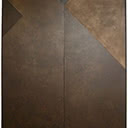Painting Dark 1968 (diptych)
228.6 x 175.2 cm
est. $120,000 - 160,000
 Relative size
Relative size
PROVENANCE
Private Collection
Petar/James Gallery, Auckland
EXHIBITED
Meta Grey and Dark Paintings,
Petar/James Gallery, Auckland November-December 1972
Now that the long and distinguished career of Milan Mrkusich (1925-2018) has ended it is possible to see that among New Zealand artists he was uniquely distinguished by his undeviating commitment to abstraction from beginning to end; he started out as a dedicated abstractionist in the mid-1940s and was still producing new abstract work well into the twenty first century - an active career of over 60 years. No other New Zealand painter pursued his chosen mode of abstraction so consistently. Even Gordon Walters, likewise committed to abstraction through most of his career, started out as a figurative artist in the 1940s before turning to abstraction. Some younger artists, such as Stephen Bambury and Roy Good have begun and kept on as wholly abstract artists, following in the line established so strongly by Mrkusich. Painting Dark 1968 (diptych) shows Mrkusich at the top of his game. But if absolute undeviating consistency was one characteristic of Mrkusich, so at the same time was continuous change and evolution from beginning to end of his career. He never gave up experimenting and trying out new things. An experienced student of Mrkusich's work could, I am sure, place any painting of his within a year or two of the date of its making solely by attending to the particular elements of colour, form, edge, texture, shape, size, materials, pigments of which they are composed.
What did abstraction mean to Mrkusich at the time this majestic work was painted (1968)? A good description is offered by Alan Wright and Edward Hanfling in their indispensable book: Mrkusich: The Art of Transformation Auckland University Press, 2009: 'The paintings contain no symbols or signs that can be read, no decipherable codes or references to a familiar world. They are non-objective, autonomous objects that refer to nothing beyond their own immediate reality' p. 60. As the authors point out, Mrkusich was always alert to developments in abstract painting abroad, especially the United States, and the amplification in size and simplification in imagery of his work at this period certainly owes something to a new generation of abstract painters in America including Frank Stella, Kenneth Noland, Morris Louis and Jules Olitski, but with one important difference.
The new American painters of the 1960s rejected the claims of their New York School predecessors such as Mark Rothko and Barnet Newman that their work had transformative sublime or metaphysical meaning and importance. Their attitude by contrast was summed up in Frank Stella's statement: All I want anyone to get out of my paintings, and all I ever get out of them, is the fact that you can see the whole idea without any confusion...What you see is what you see. Mrkusich, on the contrary, subscribed to the older idea, which ultimately derives from Mondrian and Kandinsky, that abstract paintings should have not less meaning than representational art but more. He rejected the criticism, common in New Zealand at the time, that abstraction was mere 'pattern making' or 'art for art's sake'. He said in 1969: Painting does have a content. It could be termed a speculative metaphysic... It does not exist for itself but for man as a vehicle of awareness Wright and Hanfling, p. 71.
In terms of chronology Painting Dark 1968 (diptych) belongs to the middle of Mrkusich's career, painted when he was 43 and in full flight. The painting was made at a time when corner triangles had begun appearing as a distinctive feature of his work. Initially a single such triangle quite large in scale would appear together with other elements as in, for example, Five Elements on Purple Ground, 1966 or Ambient Gold, 1967. Before long, as in Painting Red 1968, two versions, smaller triangles appeared in all four corners, while the rest of the canvas was dominated by a single uniform colour. Often square in format these 'corner paintings' became some of his most celebrated works.
Painting Dark (diptych) is intermediate between these two states and unusually involves both small and large triangles in the same work. As in the Corner paintings, four small triangles of different colours (yellow, red, blue and purple) appear in the outer corners of the work (when considered as a single object), while the upper inner corner of each panel of the diptych is a larger darker triangle (which combine to form an even larger triangle); these inner triangles are not repeated at the bottom of the picture, though there is an additional lateral triangle on the edge of the left panel. This work is more complex in structure than the corner paintings, with subtle modulations of dark brown colour occurring where the diagonals divide up the surface (there are no verticals or horizontals anywhere in the picture, apart from the line which joins the two panels of the diptych).
Whereas the Corner paintings are notable for their symmetry, Painting Dark is notably asymmetrical, whether considered as one painting or two. Diptych forms are rare (though not unknown) in Mrkusich's work and in this instance he has obviously delighted in the interplay between the painting as a single object (as accentuated by the four outer corners) and the painting as a double object with each panel having a different character. While sombre in feeling due to the overall darkness of the colours (apart from the corners), this beautiful work is simultaneously stimulating and intriguing because of the complexity of its geometry. PETER SIMPSON




